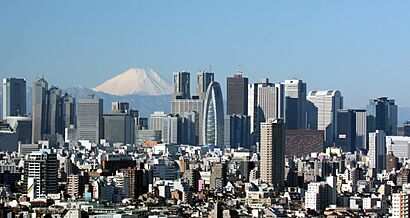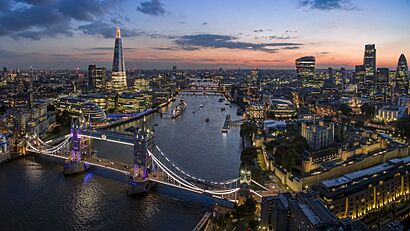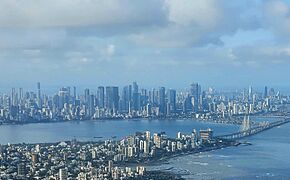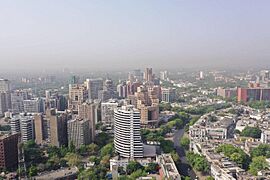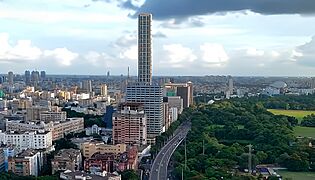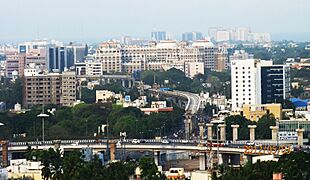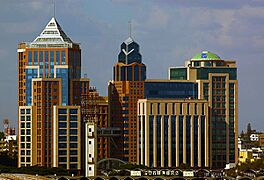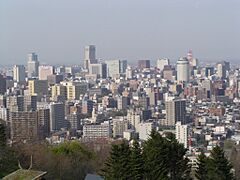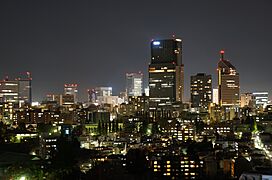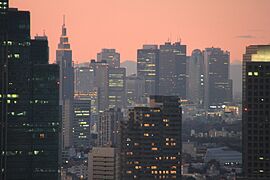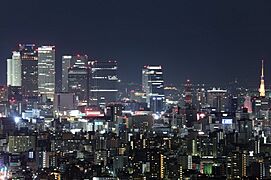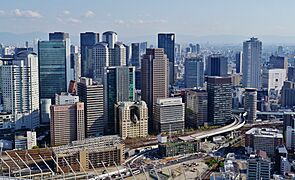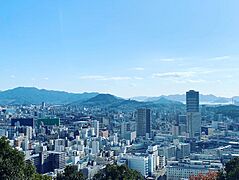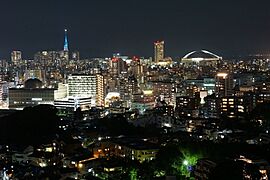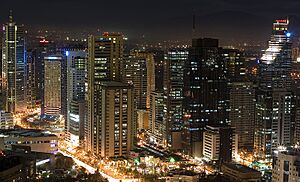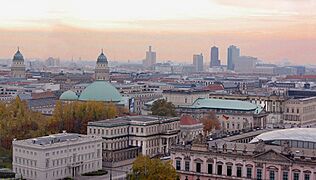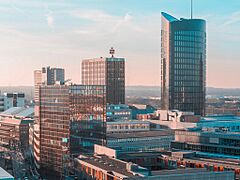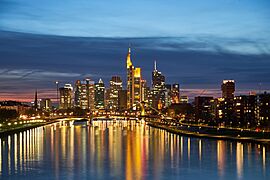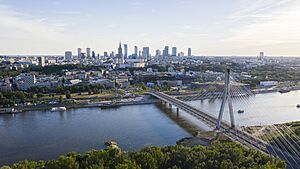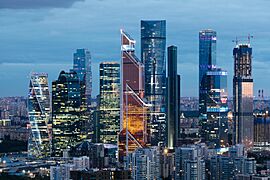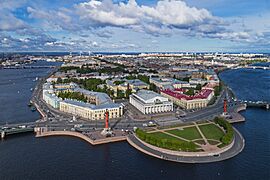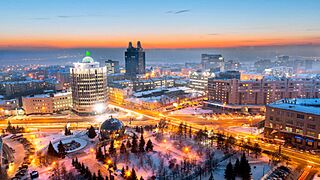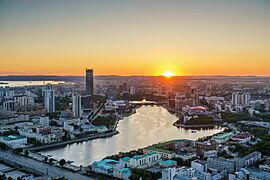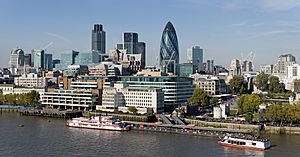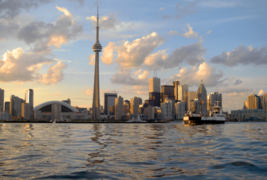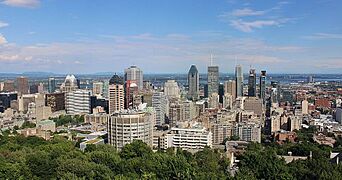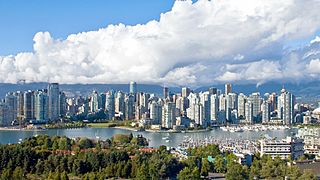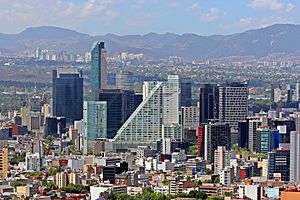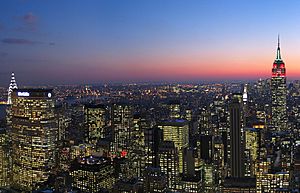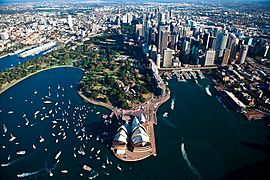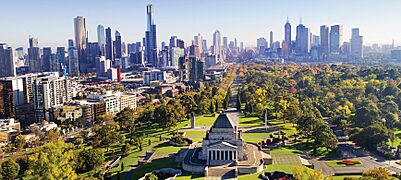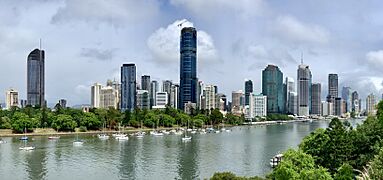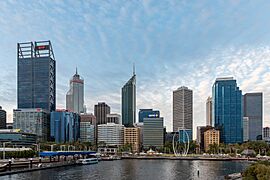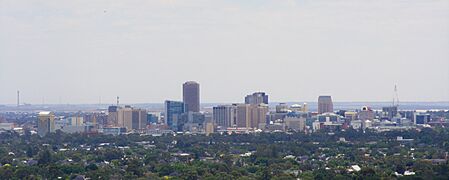Metropolis facts for kids

A metropolis is a very large city or a group of cities that are connected. It's a super important place for a country or region. Think of it as a major center for money, power, culture, and connections to other places around the world.
If a big city is part of a larger group of cities but isn't the main one, it's usually just seen as part of the metropolis, not a metropolis itself. The word "metropolises" is the most common way to say more than one metropolis.
For smaller cities that are important to their region but aren't huge metropolises, there's a term called "regiopolis."
Contents
What Does "Metropolis" Mean?
The word metropolis comes from ancient Greek. It combines two words: mḗtēr, meaning "mother," and pólis, meaning "city" or "town."
Long ago, when the Greeks started new settlements (colonies) in other lands, they called their original home city the "mother city" or metropolis. These colonies kept strong ties with their mother cities. Later, the word "metropolis" grew to mean any very large and important city in a country.
Metropolises in Africa
Angola
Luanda is the capital and biggest city in Angola. It's Angola's main port and a major center for industry, culture, and city life. Over 8.3 million people live in its metropolitan area, making it the largest Portuguese-speaking city in Africa.
Democratic Republic of Congo
Kinshasa is a huge city with about 15 million people. It's the third-largest urban area in Africa, after Cairo and Lagos. Experts think it could be one of the ten biggest cities in the world by 2050.
Egypt
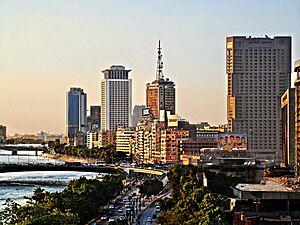
Cairo and Alexandria are considered Egypt's largest metropolises.
Ethiopia
Addis Ababa is the capital city of Ethiopia. It's also where the African Union has its main office. As of 2008, about 4.5 million people live in its metro area.
Ghana
Accra is a key center for business and government in Ghana. It's the main city in the larger Greater Accra Metropolitan Area.
Ivory Coast
In 2014, Abidjan had 4.7 million people, which was 20% of the country's total population. This made it the sixth most populated city in Africa. It's officially known as the "economic capital" of the country. By 2020, its urban area had over 5 million people.
Kenya
Nairobi is the capital and largest city of Kenya. In 2019, the city itself had about 4.4 million people, while the larger metropolitan area had over 9.3 million.
Nigeria
Lagos is expected to be one of the ten biggest cities globally by 2050. In 2015, unofficial numbers showed that "Greater Metropolitan Lagos," which includes Lagos and its nearby areas, had about 21 million people.
Tanzania
Dar es Salaam is one of the fastest-growing cities in Africa, with its population increasing by 5.6% each year from 2002 to 2012. It's expected to reach 15.12 million people by 2020.
South Africa
The biggest city in South Africa is Johannesburg, a major business hub with about 5.6 million people in its metro area in 2019. Next are Cape Town (about 4.5 million) and Durban (about 3.1 million). Smaller metropolises in South Africa include Pretoria, East Rand, Gqeberha, East London, and Bloemfontein.
Uganda
Kampala is the capital and largest city of Uganda. Its metropolitan area had an estimated 6.7 million people in 2019. Kampala is one of Africa's fastest-growing cities, with a population growth rate of over 4% per year.
Metropolises in Asia
Afghanistan
The capital city, Kabul, has become Afghanistan's only metropolis. It's the only city in the country with more than one million people.
Bangladesh
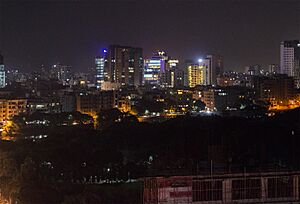
Bangladesh has eleven metropolitan areas. These include Dhaka, Chittagong, Rajshahi, Rangpur, Sylhet, Khulna, Mymensingh, Cumilla, Barisal, Gazipur, and Narayanganj. Land in these cities is expensive, and people are thought to have a better city lifestyle. Special police and city governments are set up for these areas. Dhaka is the richest city and is considered a megacity because its population is over 10 million.
China

China is the second most populated country in the world, with over 1.4 billion people. It has many metropolises, which are grouped into different "tiers." The biggest ones, called "First-Tier Cities," are Beijing, Shanghai, Guangzhou, and Shenzhen.
Many of China's metropolises are part of huge "city clusters," like the Yangtze River Delta Megalopolis and the Pearl River Delta Megalopolis.
India
India is the most populated country in the world, with over 1.5 billion people. The Indian Constitution says a metropolitan area is a place with 1 million or more people, made up of two or more towns or villages. As of 2011, India had 46 cities with over one million people. Some of the largest metropolitan cities include Delhi, Mumbai, Kolkata, Chennai, Bangalore, Hyderabad, Pune, Ahmedabad, and Kochi.
-
Mumbai, India's financial center.
-
New Delhi, India's capital.
-
Kolkata, India's cultural capital.
-
Chennai, India's healthcare capital.
-
Bengaluru, India's IT capital.
Indonesia

In Indonesia, the main metropolitan cities are in the Jabodetabek region, which includes Jakarta, Bekasi, Bogor, Depok, and Tangerang. This is the biggest metropolitan area in Southeast Asia and the fifth biggest in the world (as of 2007). Other metropolises include Bandung, Batam, Medan, Semarang, and Surabaya.
Iran

In Iran, the main metropolitan cities are Greater Tehran and Greater Isfahan Metropolitan Area. Other important cities include Mashhad, Karaj, Shiraz, Tabriz, Qom, Ahvaz, Kermanshah, and Rasht.
Japan
In Japan, the legal term to is translated as "metropolis." There is only one to in Japan, which is Tokyo. Tokyo is set up like a prefecture (a type of region) rather than a normal city. As of 2020, Japan has 12 other cities with populations over one million.
-
Sapporo, in the Hokkaidō region.
-
Sendai, in the Tōhoku region.
-
Tokyo, in the Kantō region.
-
Nagoya, in the Chūbu region.
-
Osaka, in the Kansai region.
-
Hiroshima, in the Chūgoku region.
-
Fukuoka, in the Kyushu region.
Malaysia
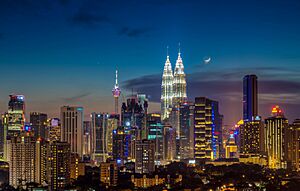
In Malaysia, the capital city Kuala Lumpur is the largest, with a population of 7.8 million. Other metropolises in Malaysia include Johor Bahru, Seremban, Malacca City, Shah Alam, Kuantan, Kuala Terengganu, Kota Bahru, Ipoh, Georgetown, Alor Setar, Kangar, Kota Kinabalu, and Kuching.
Pakistan
According to the 2017 census, Pakistan has about 12 metropolitan areas, each with at least 2 million people in their metro area. Karachi is the largest, with about 19.31 million people. It's followed by Lahore (15.12 million), Faisalabad (9.873 million), Islamabad-Rawalpindi (8.412 million), Gujranwala (7.01 million), Multan (4.745 million), Peshawar (4.269 million), Sargodha (3.903 million), Sialkot (3.893 million), Bahawalpur (3.668 million), Quetta (2.275 million), and Hyderabad (2.199 million).
Philippines
The Philippines has three main metropolises: Manila, Cebu, and Davao.
Metropolitan Manila, or Metro Manila, is a large region that includes the city of Manila and its surrounding areas. It's made up of 16 cities and 1 town. This region is the center for politics, economy, social life, culture, and education in the Philippines. Metro Manila is the country's seat of government, but the city of Manila is the capital. The largest city in this metropolis is Quezon City, and the biggest business area is the Makati Central Business District.
Singapore
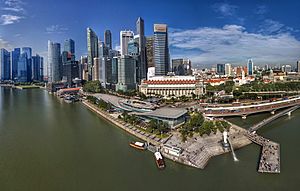
The Republic of Singapore is an island country and city-state in Southeast Asia. It does not have a separate capital city because the entire country is essentially one large city.
South Korea
In South Korea, there are seven special and metropolitan cities that have their own administrative powers. These are the most populated metropolitan areas in the country. From largest to smallest population (2015 census), they are Seoul, Busan, Incheon, Daegu, Daejeon, Gwangju, and Ulsan.
Sri Lanka
The City of Colombo is the largest city in Sri Lanka. The Colombo Metropolitan Area is Sri Lanka's most developed urban region, with over 5 million people.
Taiwan
Taipei City is the main center for politics, economy, and culture in Taiwan. The Taipei–Keelung metropolitan area includes 4 areas and has over 9 million residents. This metropolis is home to Taiwan's largest international airport, which handles nearly 50 million passengers each year.
Turkey
In Turkey, metropolitan cities are called "büyükşehir." There are 30 metropolitan municipalities in Turkey. The largest by far is Istanbul, followed by Ankara, İzmir, and Bursa.
United Arab Emirates

There are 8 metropolises in the UAE: Dubai, Abu Dhabi, Sharjah, Al Ain, Ajman, Ras Al-Khaimah, Fujairah, and Umm Al-Quwain. Dubai is the largest of these.
Kazakhstan
Almaty is Kazakhstan’s largest metropolitan area, with over 2 million people. Other cities with over a million people include Astana and Shymkent.
Uzbekistan
Tashkent is Uzbekistan's most populated and largest city. It's the only city with over 3 million residents. Other large cities are Samarkand, Bukhara, and Fergana.
Metropolises in Europe
Austria
Vienna is the capital city of Austria. It's an old imperial city and home to many international groups, like OPEC and a main office of the United Nations. Because of its rich culture and history, Vienna is a truly global metropolis, and the only one in Austria.
Belgium
The region of Brussels is the capital city of Belgium, with over 1.2 million people. It's the largest urban area in the Benelux region (Belgium, Netherlands, Luxembourg). Brussels is where the European Union, NATO, and other international groups are located. It's often called the 'Capital of Europe'.
Bosnia and Herzegovina
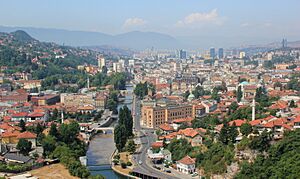
Sarajevo is the capital and largest city of Bosnia and Herzegovina. It's where the country's government and parliament are located, and it's the only metropolis in the country.
Czech Republic
Prague is the Czech Republic's only metropolis. More than 1.3 million people live in the city itself, and over 2.6 million live in its metropolitan area. This makes the Prague metropolitan area one of the largest in Europe.
Denmark
In Denmark, the only metropolis is the capital, Copenhagen. It's located in the Capital Region of Denmark. Over 750,000 people live in the city, and 1.28 million live in its urban area.
Finland
Finland's capital, Helsinki, along with nearby areas like Espoo, Kauniainen, and Vantaa, forms a metropolitan area with about 1.45 million people. This area is the only metropolis in Finland.
France
A law in 2014 allowed groups of towns (called communes) to work together in a larger administrative area called a métropole. One métropole, Lyon, also acts as a department (a type of region).
France's national statistics group lists 12 of the country's urban areas as metropolitan areas. Paris, Lyon, and Marseille are the biggest. The other nine are Toulouse, Lille, Bordeaux, Nice, Nantes, Strasbourg, Rennes, Grenoble, and Montpellier.
Germany
The largest German city by its official borders is Berlin. However, Rhine-Ruhr is the largest metropolitan area, with over 10 million people. The importance of a city is measured by how well it handles decision-making, new ideas, and connecting to other places.
In city planning, a metropolis is usually looked at with its surrounding region. Germany has defined eleven metropolitan regions based on these factors: Berlin-Brandenburg, Bremen-Oldenburg, Dresden-Halle-Leipzig, Frankfurt-Rhine-Main, Hamburg, Hannover-Braunschweig-Göttingen-Wolfsburg, Munich, Nuremberg, Rhine-Neckar, Rhine-Ruhr (which includes Cologne/Bonn), and Stuttgart.
-
Berlin is Germany's largest city.
-
Rhine-Ruhr is Germany's largest metropolis (the photo shows Dortmund).
-
Frankfurt is one of Germany's most important cities.
Greece
Athens is the capital and largest city of Greece, with over 4 million people in its urban area. It's also the 8th largest urban area in the European Union. Athens is one of the world's oldest cities, with a history going back over 3,400 years. Along with the port of Piraeus, Athens is a very important center for business and culture in the Eastern Mediterranean. At the heart of ancient Athens is the famous Acropolis of Athens, a UNESCO World Heritage site from the 5th century BCE. It was built to honor the Goddess Athena and includes the Parthenon, a masterpiece of ancient architecture. The Acropolis represents the peak of Greek civilization, which laid the groundwork for modern Western ideas in art, philosophy, theater, music, mathematics, and science. Today, Athens welcomes over 6.4 million visitors every year.
Hungary
Budapest has a population of 1,750,000, which is more than eight times the population of the second largest city, Debrecen.
Italy
As of January 1, 2015, Italy has 14 "metropolitan cities." Large cities like Rome, Milan, and Naples have joined with their surrounding urban areas to form these new entities. About one out of three Italians live in these metropolitan cities.
Netherlands
The Randstad is a large urban area that includes both the Amsterdam metropolitan area and Rotterdam–The Hague metropolitan area.
Poland
The Union of Polish Metropolises is a group of the country's largest cities, started in 1990. Currently, twelve cities are members, and 11 of them have over a quarter-million people. The largest metropolitan area in Poland is the Katowice metropolitan area, with about 3 million people. This area is trying to officially unite into one urban unit called the Metropolis GZM. Next is Warsaw, with about 1.7 million people in the city and 3.1 million in its metropolitan area. Other Polish metropolises include Kraków, Łódź, Wrocław, Poznań, Tricity, Szczecin, and Bydgoszcz–Toruń.
Romania
Romania has one big metropolis, Bucharest, with about 2.5 million people. Other metropolitan areas with about half a million people include Cluj-Napoca, Iași, Timișoara, Brașov, Constanța, Galați, and Craiova.
Russia
Moscow is the capital and largest city of Russia. It has about 12.4 million people within the city limits, over 17 million in its urban area, and over 20 million in the Moscow Metropolitan Area. Moscow is one of the world's largest cities. It's the most populated city and urban area entirely within Europe, and also the largest city by land area on the European continent. Saint Petersburg, known for its culture, is the second-largest city, with about 5.4 million people. Other major urban areas are Yekaterinburg, Novosibirsk, Kazan, Nizhny Novgorod, and Krasnodar.
-
Saint Petersburg, the cultural capital and second-largest city.
-
Novosibirsk, the largest city in Siberia and third-largest city overall.
-
Yekaterinburg, the fourth-largest city in the country.
Spain

Spain has about 15 metropolitan areas with over 500,000 people. The largest is Madrid, located in the center of Spain. It's where the government and the monarch live, and its metropolitan area has almost 7 million people, making it one of Europe's largest. Barcelona is Spain's second-largest city, with 5.5 million people in its metropolitan area. Other large cities include Valencia, Zaragoza, and Sevilla.
United Kingdom
In the United Kingdom, the term the Metropolis used to refer only to London. The London police force, the Metropolitan Police Service, still uses this term.
Since 1974, six large urban areas in England (outside London) have been called metropolitan counties. These include South Yorkshire (around Sheffield), the West Midlands (including Birmingham), West Yorkshire (including Leeds), Merseyside (including Liverpool), Greater Manchester, and Tyne & Wear (including Newcastle-upon-Tyne). Other large urban areas with over half a million people are Greater Glasgow, South Hampshire, Greater Nottingham, Greater Bristol, Belfast metropolitan area, and Greater Leicester.
Sweden
In Sweden, the term "the Metropolis" historically referred only to Stockholm or Greater Stockholm. These areas are known as metropolitan counties, divided into metropolitan districts. These counties include Stockholm County, Västra Götaland County, Skåne County, Dalarna County, Norrbotten County, Västerbotten County, Gävleborg County, and more. These are also large urban areas.
Metropolises in North America
Canada
Canada's six largest metropolises are Toronto, Montreal, Vancouver, Ottawa, Calgary, and Edmonton. Statistics Canada defines a metropolitan area as one or more nearby towns or cities around a main urban center that has at least 100,000 people. Canada's most populated metropolis is the City of Toronto, with 2.7 million people and a metropolitan population of over 6 million. It's also the center of Canada's finance and banking industry.
-
Toronto is Canada's largest city.
-
Montreal is Canada's largest French-speaking city.
-
Vancouver is Canada's largest coastal city and most important port.
Mexico
In Mexico, a metropolis is an urban area that is important for its economy, politics, and culture. Mexico City fits all these descriptions, as it's the country's capital and financial center with 27 million people. Other metropolises are Monterrey and Guadalajara, both with over 6 million people in their metropolitan areas.
United States
In the United States, an official city or group of areas with over 50,000 people must have a special planning group for big building projects. So, a population of 50,000 or more is often used to define a metropolis in the U.S. The United States Census Bureau uses a similar idea, defining a metropolitan area as having "at least one urbanized area of 50,000 or more inhabitants." The six largest metropolitan areas in the USA are New York, Los Angeles, Chicago, Dallas, Houston, and Washington, D.C., with New York being the largest.
Metropolises in Oceania
Australia
The Australian Bureau of Statistics says a metropolitan area is any region with over 100,000 people. By this definition, Australia currently has 19 metropolitan areas, including every state capital. Sydney is the largest, with an urban population of about 5.3 million in 2020. The smallest is Bendigo, with about 100,632 people. Fast growth in Victoria has led to more tall buildings in Melbourne's suburbs. The regional city of Geelong, about 40 miles southwest of Melbourne, has also seen new high-rise buildings. Geelong is Australia's fastest-growing regional city.
-
Sydney is Australia's largest metropolis.
-
Melbourne is Australia's second-largest metropolis.
-
Brisbane is Australia's third-largest metropolis.
-
Perth is the largest city in Western Australia.
-
Adelaide is the largest city in South Australia.
Metropolises in South America
Argentina

In Argentina, Buenos Aires is the main metropolis, with about 15.5 million people. The Greater Buenos Aires area is the third-largest urban area in Latin America. Buenos Aires is the main center for politics, money, industry, business, and culture in Argentina.
Brazil

In Brazil, Greater São Paulo is the main metropolis, with over 21 million people. In large cities like São Paulo and Rio de Janeiro (12 million people), informal settlements (called favelas) grew over many years as people moved from rural areas to find work. The term for a metropolitan area in Brazil is Região Metropolitana. Other metropolises in Brazil with over one million people include: Belém, Belo Horizonte, Brasília, Campinas, Curitiba, Fortaleza, Goiânia, Maceió, Manaus, Porto Alegre, Recife, Salvador, and São Luís.
Chile
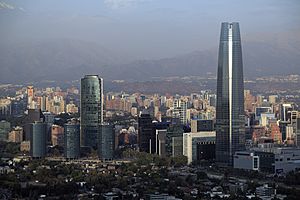
The main metropolis in Chile is its capital, Santiago, with 7 million people living in its metropolitan area. Santiago is the main center for politics, money, industry, business, and culture in Chile. The other two metropolises in the country are Valparaíso and Concepción, each with nearly one million people.
Colombia
In Colombia, Bogotá is the main metropolis, with over 13 million people in its Metropolitan Area. This area includes towns like Soacha, Mosquera, Cota, and Chía. The second metropolis in Colombia is Medellín, which includes towns like Envigado, Itagüi, La Estrella, and Sabaneta. Medellín is known for having Colombia's first and only subway system. Bogotá has a fast bus system called Transmilenio.
Peru
The Lima metropolitan area is Peru's capital and largest city, with over 10 million people. This is more than one-third of the country's total population.
Metropolis as a Mainland Area
In some countries like France, Portugal, Spain, and the Netherlands, the word metropolis can also mean the main part of the country that is on or close to the European mainland. For example, in France, "métropole" means France without its overseas regions. For Portugal and Spain during their empires, the term meant Portugal or Spain without their colonies. In France, métropole can also refer to a large urban area, like "La Métropole de Lyon."
See also
 In Spanish: Metrópoli para niños
In Spanish: Metrópoli para niños


